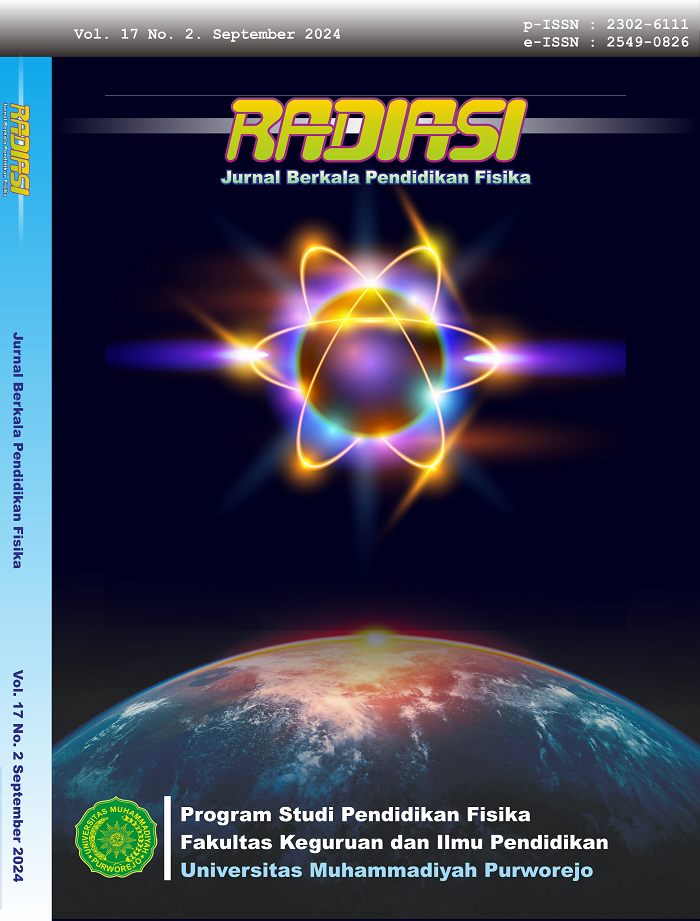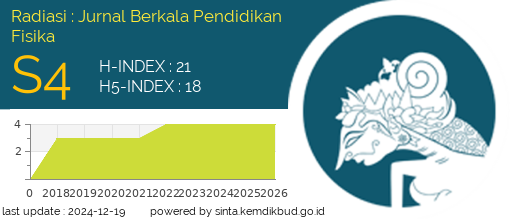Development of Practicum Tools for Learning the Concept of Light Interference Assisted by the ESP-32 Camera Sensor to Practice Science Process Skills
Abstract
This research aims to develop a practicum tools with assisted by the ESP-32 camera sensor which can be used in learning the matter of light interference at school, as well as to train science process skills. This research uses a Design and Development Research (DDR) approach, which is divided into three stages, that are analysis, design and development, and eval_uation. Before this practicum tool is used in the field to help the learning process, this practicum tool is tested for feasibility first. The feasibility test of the practicum tools for the matter of light interference was carried out using a validity test and practicality test. The results of the practicum tools validity test obtained a percentage of 86% with a very valid category and the indicator for the usefulness of practicum tools in science process skills was 81%. The results of the practicality test obtained a percentage of 84% in the very practicality category. Based on these two feasibility tests, it can be concluded that the practicum tool is suitable for use in learning the matter of light interference at school, and can train students' science process skills. Indicators of scientific process skills that are trained are observing, communicating, controlling variables, hypothesizing, experimentation, and interpreting data.
Downloads
References
Redhana, I. W, “Mengembangkan Keterampilan Abad ke-21 dalam Pembelajaran Kimia,” Jurnal Inovasi Pendidikan Kimia, vol 13, no. 1, pp. 2239-2253, 2019.
S. S. Edie et al., “The Effect of Using Bomb Calorimeter in Improving Science Process Skills of Physics Students,” in Journal of Physics: Conference Series, Institute of Physics Publishing, Apr. 2018. Doi: 10.1088/1742-6596/983/1/012205.
A. H. Zeidan and M. R. Jayosi, “Science Process Skills and Attitudes toward Science among Palestinian Secondary School Students,” World Journal of Education, vol. 5, no. 1, 2014. Doi: 10.5430/wje.v5n1p13.
A. Wijaya, C. Ertikanto, D. Andra, and K. Herlina, “JIPF (Jurnal Ilmu Pendidikan Fisika) Development of Simple Light Diffraction Props Assisted by Tracker Application with Camera Module and Arduino UNO,” vol. 7, no. 3, 2022. Doi: 10.26737/jipf.v7i3.2989.
R. Dai, J. C. Fritchman, Q. Liu, Y. Xiao, H. Yu, and L. Bao, “Assessment of Student Understanding on Light Interference,” Phys Rev Phys Educ Res, vol. 15, no. 2, Oct. 2019. Doi: 10.1103/PhysRevPhysEducRes.15.020134.
Lutfia, W., & Putra, N. M, “Analisis Profil Pemahaman Konsep dan Model Mental Siswa di SMA Kesatrian 2 Semarang pada Materi Interferensi dan Difraksi Cahaya,” Unnes Physics Education Journal,vol. 9, no. 1, pp. 27-35, 2020.
Putra, R. A, “Peran Teknologi Digital dalam Perkembangan Dunia Perancangan Arsitektur,” Journal of Islamic Science and Technology, vol. 4, no. 1, pp. 67-78, 2018.
E. T. Ong, P. Ramiah, K. Ruthven, S. M. Salleh, N. A. N. Yusuff, and S. E. Mokhsein, “Acquisition of Basic Science Process Skills Among Malaysian Upper Primary Students,” Research in Education, vol. 94, no. 1, pp. 88–101, Nov. 2015. Doi: 10.7227/RIE.0021.
R. O. Ongowo and F. C. Indoshi, “Science Process Skills in the Kenya Certificate of Secondary Education Biology Practikum Examinations,” Creat Educ, vol. 04, no. 11, pp. 713–717, 2013. Doi: 10.4236/ce.2013.411101.
R. C. & K. J. D. Richey, Design and Development Research, Method, Strategies, and Issues. London: Lawrenc Erlbaum Associates, 2007.
D. Novisya, “Penilaian Instrumen Efektifitas Video Pembelajaran Fisika Berbasis Contextual Teaching and Learning (CTL) Materi Fluida.”
A. Ahadillailah, A. Suherman, and A. Saefullah, “Development of Phymol Integrated Media (Physics Mobile Learning) on Temperature and Heat in High School Physics Learning,” Radiasi : Jurnal Berkala Pendidikan Fisika, vol. 16, no. 1, pp. 17–25, May 2023. Doi: 10.37729/radiasi.v16i1.1737.
J. Walker, Fundamentals of Physics Halliday & Resnick, 9th ed. United States of America: John Wiley & Sons, Inc., 2011.
N. J. Giordano, College Physics: Reasoning and Relationship, 1st ed. USA: Brooks/Cole, 2010.
Y. P. Diniarti, K. Dwiningsih, J. Kimia, and F. Unesa, “Implementation Hands-On and Minds-On Activity Approach Through Guided Inquiry on the Subject Matters of the Factors That Affect the Reaction Rate in the Class of XI IPA SMAN 1 Sooko Mojokerto,” UNESA Journal of Chemical Education, vol. 4, no. 2, pp. 401–408, 2015.
E. L. , & K. T. R. Chiappetta, Science Instruction in the Middle and Secondary Schools. Upper Saddle River, NJ: Prentice-Hall, 2002.
Copyright (c) 2024 Dita Shanda Putri, Kartini Herlina, Anggreini Anggreini

This work is licensed under a Creative Commons Attribution-NonCommercial 4.0 International License.




